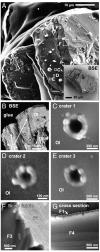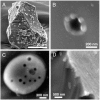Space environment of an asteroid preserved on micrograins returned by the Hayabusa spacecraft
- PMID: 22371561
- PMCID: PMC3306700
- DOI: 10.1073/pnas.1116236109
Space environment of an asteroid preserved on micrograins returned by the Hayabusa spacecraft
Abstract
Records of micrometeorite collisions at down to submicron scales were discovered on dust grains recovered from near-Earth asteroid 25143 (Itokawa). Because the grains were sampled from very near the surface of the asteroid, by the Hayabusa spacecraft, their surfaces reflect the low-gravity space environment influencing the physical nature of the asteroid exterior. The space environment was examined by description of grain surfaces and asteroidal scenes were reconstructed. Chemical and O isotope compositions of five lithic grains, with diameters near 50 μm, indicate that the uppermost layer of the rubble-pile-textured Itokawa is largely composed of equilibrated LL-ordinary-chondrite-like material with superimposed effects of collisions. The surfaces of the grains are dominated by fractures, and the fracture planes contain not only sub-μm-sized craters but also a large number of sub-μm- to several-μm-sized adhered particles, some of the latter composed of glass. The size distribution and chemical compositions of the adhered particles, together with the occurrences of the sub-μm-sized craters, suggest formation by hypervelocity collisions of micrometeorites at down to nm scales, a process expected in the physically hostile environment at an asteroid's surface. We describe impact-related phenomena, ranging in scale from 10(-9) to 10(4) meters, demonstrating the central role played by impact processes in the long-term evolution of planetary bodies. Impact appears to be an important process shaping the exteriors of not only large planetary bodies, such as the moon, but also low-gravity bodies such as asteroids.
Conflict of interest statement
The authors declare no conflict of interest.
Figures







References
-
- Fujiwara A, et al. The rubble-pile asteroid Itokawa as observed by Hayabusa. Science. 2006;312:1330–1334. - PubMed
-
- Saito J, et al. Detailed images of asteroid 25143 Itokawa from Hayabusa. Science. 2006;312:1341–1344. - PubMed
-
- Demura H, et al. Pole and global shape of 25143 Itokawa. Science. 2006;312:1347–1349. - PubMed
-
- Yano H, et al. Touchdown of the Hayabusa spacecraft at the Muses Sea on Itokawa. Science. 2006;312:1350–1353. - PubMed
-
- Yurimoto H, et al. Oxygen isotopic compositions of asteroidal materials returned from Itokawa by the Hayabusa mission. Science. 2011;333:1116–1119. - PubMed
LinkOut - more resources
Full Text Sources

